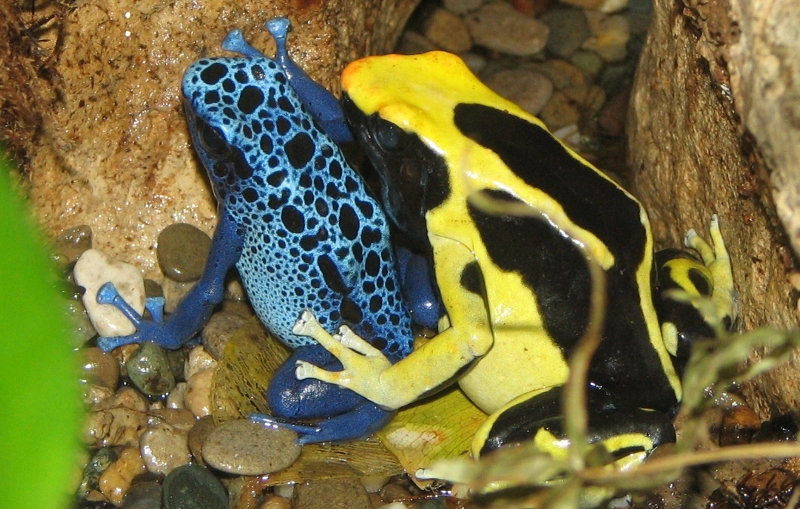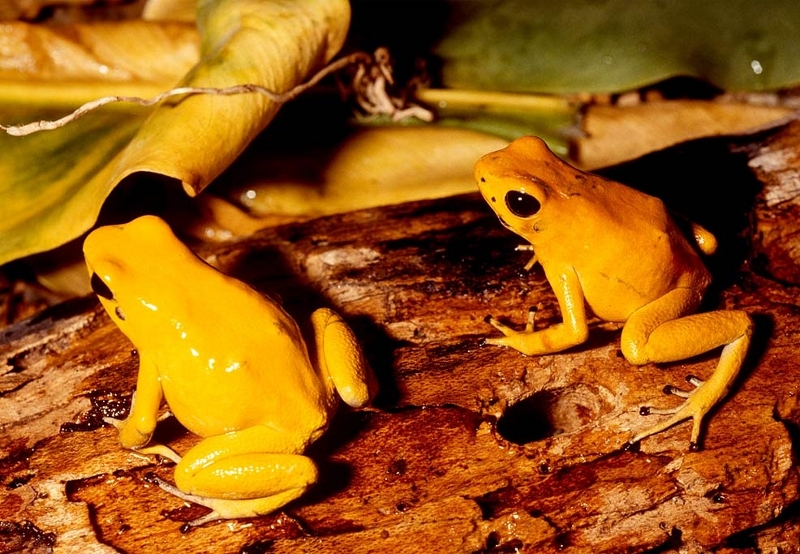Poison Dart Frog – The Deadliest Frog on Earth
- Published by
- Posted on
- Leave your thoughts
-

What differentiate a Poison dart Frog from a common frog are its vibrant colors and a body covered with bands or spots.
All of those who believe that, “size does matter”; think again because a tiny amphibian like the Poison Dart Frog can be as deadly as a big sized reptile. Coming from the family of Dendrobatidae, this amazing specie of frog is found in the rain forests of Central and South America, stretching from Costa Rica to Brazil; these areas are tropical and have a humid climate. The family of frogs is further divided into two main groups of species i.e.
- Dendrobates auratus (green poison dart frog)
- Dendrobates tinctorius (dyeing poison dart frog).

The Dendrobates auratus is a small sized frog and reaches a size of about 2.5 to 4 cm and in some cases they may reach to a size of 6cm. The other specie Dendrobates tinctorius is larger in size as compared to Dendrobates auratus as they reach a size of 4cm to 6cm. The smallest Poison dart frog has a size relative to a paper clip.
What differentiate a Poison dart Frog from a common frog are its vibrant colors and a body covered with bands or spots. The colors of their body may range from green, light blue, red, gold, copper or black, depending on their geographic location. The spots or stripes are found in green, yellow-green, blue, blue-green or white color. It is said that the vibrant colors of these frogs are their natural defense mechanism and is a signal to their predators that they are poisonous; this tactic is also known as, “Aposematic Coloration” and is similar to Monarch Butterfly. Scientists also believe that their body colors and patterns also help them to camouflage with in the forest shadows.
The Poison Dart Frog is also known by the names of Poison Arrow Frog, Poison Frog and Phantasmal Poison Frog but the most common element among all these names is, “Poison”. But how was this name derived? The names speak for themselves, since the past Amerindian tribes have been using the secretions from the poison arrow frogs to poison the tips of their blow darts and arrows. The secretion is known to be lipophilic alkaloid toxin.
The toxicity level of the poison frogs varies from specie to specie, so far 3 main species have found to be poisonous. However the source of the poison is yet to be discovered, it is assumed that the poison is obtained from its diet which includes beetles, termites and ants that feed on tropical plants containing poison; the prey is captured with the help of sticky tongue that can retract. Whenever the frog senses danger the venom is secreted from the glands found on its back.

The golden poison dart frog is the deadliest among Poison Dart Frog family
The golden poison dart frog is the deadliest among this frog specie as one frog is believed to have enough poison to kill 10 people. It is 5 cm long and has been claimed to be, “The most toxic vertebrate on earth”. The only predator that can survive its deadly venom is a snake called, “Leimadophis epinephelus”.
However humans can handle poison dart frog as the secretion cannot do any harm as long as it does not enter the blood stream. The poison cannot enter into the unbroken skin and it is essential for the person handling the frog to determine that there are no cuts on the skin; the other possible way for the poison to enter the body is through ingestion.
Scientists are making discoveries to use the poison dart frog’s venom for medicinal purposes and so far they have been successful in developing a synthetic compound essential for relieving pain.
The mating season begins in mid-July and continues till mid-September. The males use their trill voices to attract females. Although the eggs are laid by female poison dart frog; it is the male’s duty to care after the tadpoles and feed them. The eggs are laid on green leaves and are usually 40 in number and a gelatinous substance encases the eggs that protect them from desiccation. Male frogs periodically check the eggs during two-week time and once they hatch the tadpoles get on to the male’s back and are carried to places where further development can take place including little ponds, tree holes and wet coconut shells.
It is an amazing fact that poison arrow frogs are bad swimmers and they mostly live in trees or on land. 1 gram of toxin secretion of golden poison dart frog is enough to kill 1000 humans, whereas poison dart frogs kept in captivity do not secrete toxin at all and are not venomous. The toxin has also been helpful for developing muscle relaxants and appetite reducers.
The average life span of these type of frongs is 3 to 5 years in wild and more than 10 years in captivity. The golden poison arrow and blue poison dart frogs are endangered species due to loss of habitat, environmental changes and captivity.





